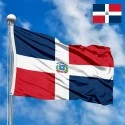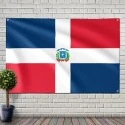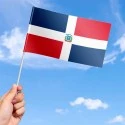The national flag of the Dominican Republic is a powerful and unique symbol, rich with religious and historical meaning. Its design, with a prominent white cross at its center, sets it apart from all other national flags. It is a source of immense national pride, embodying the nation's struggle for independence, its strong faith, and its commitment to freedom and justice. The flag represents a nation that has overcome adversity to establish its own sovereign identity, making it a revered emblem for every Dominican.
A Detailed Look at the Flag's Design and Symbolism
The flag of the Dominican Republic is a distinctive banner divided by a large white cross that extends to the edges. The cross forms four rectangular sections, or cantons. The upper-left and lower-right cantons are blue, while the upper-right and lower-left cantons are red. The national coat of arms is placed at the center of the white cross on the state flag.
Each color and element on the flag is deeply symbolic, reflecting the core principles of the Dominican nation:
-
Blue: The blue color represents liberty and freedom. It symbolizes the clear sky of the nation and the high ideals of its people. It is a tribute to the long and arduous struggle for independence from foreign rule and the promise of a free and just society.
-
Red: The red color symbolizes the blood shed by the heroes of the nation's fight for independence. It is a tribute to the courage, sacrifice, and valor of the Dominican people who fought for their sovereignty. It is a reminder of the nation’s enduring spirit and resilience.
-
White: The white cross, which is the most prominent feature of the flag, represents salvation and peace. It symbolizes the unity of the Dominican people and the deep-seated faith that holds the nation together. The cross is a testament to the nation’s Christian heritage and its peaceful nature. It also serves as a symbol of the struggle for independence from Haiti, which involved the establishment of a peaceful and free state.
The Intricate Coat of Arms
The national coat of arms, a complex and detailed emblem, is placed at the center of the white cross. Its design is a profound symbol of the nation's history, faith, and identity.
-
The Cross and Bible: The most striking feature of the coat of arms is the shield, which is flanked by six Dominican flags (three on each side) and topped by a blue ribbon with the national motto. At the center of the shield is a small cross and an open Bible, which is traditionally open to the Gospel of John, chapter 8, verse 32, which reads: "Y la verdad os hará libres" ("And the truth shall set you free"). This powerful religious symbol is unique to the Dominican flag and is a testament to the nation’s profound faith.
-
The National Motto: The shield is flanked by a laurel branch on the left and a palm branch on the right. The laurel branch symbolizes victory and honor, while the palm branch represents liberty and independence. At the bottom of the shield, on a red ribbon, is the national motto: "Dios, Patria, Libertad" ("God, Fatherland, Liberty"). This motto encapsulates the core values of the Dominican Republic.
Dimensions and Proportions
The official flag of the Dominican Republic has a width-to-length ratio of 2:3. The white cross is a central feature, with its arms extending to the edges of the flag. The four quadrants of the flag are of equal size. The coat of arms, when present, is carefully centered on the cross. The flag is a testament to a harmonious and balanced design that reflects the nation’s balanced values.
The Genesis and Adoption of the Flag
The history of the Dominican flag is deeply rooted in the nation's struggle for independence. The flag's design was conceived by Juan Pablo Duarte, the founder of the secret society "La Trinitaria," which led the fight for independence from Haiti. The original flag, which did not include the white cross, was created by the society’s members. The white cross was later added to distinguish the new nation's flag from the Haitian one and to symbolize the deep faith of the Dominican people.
The flag was officially adopted as the national banner on November 6, 1844, after the Dominican Republic declared its independence. The flag’s design has remained largely unchanged since its inception, a testament to the enduring vision of its founders and the unwavering will of the Dominican people.
Meaning and Significance for Citizens
For the people of the Dominican Republic, the flag is not just a national symbol; it is a profound representation of their history, faith, and identity. The flag is a central feature of national life, proudly displayed on government buildings, schools, and homes, especially during national holidays such as Independence Day on February 27th.
The flag's symbolism of faith, independence, and liberty resonates deeply with the populace, serving as a reminder of the values that unite them. It is a powerful symbol of defiance and a beacon of national sovereignty. For Dominicans living abroad, the flag is a tangible link to their homeland, a source of community solidarity, and a powerful emblem of their identity.
Interesting Facts
-
The flag is one of only a few national flags in the world to feature a Bible. This is a powerful testament to the deep-seated faith of the Dominican people and the role of religion in the nation’s history.
-
The flag's design, with its alternating red and blue quadrants, is a reference to the Haitian flag, but with the addition of the white cross to symbolize the new nation’s unique identity and faith.
-
The national motto, "Dios, Patria, Libertad," is not just a phrase; it is a concise summary of the nation's core principles.
-
The flag has two versions: the civil flag, which is the striped banner without the coat of arms, and the state flag, which includes the coat of arms. The civil flag is used by private citizens, while the state flag is used for official purposes.
-
The flag is often referred to as the "bandera tricolor," or "tricolor flag," a common nickname that reflects its three main colors.
Ultimately, the flag of the Dominican Republic is a beautiful and complex tapestry of history, faith, and national pride. Its design and colors tell a comprehensive and moving story of a nation’s birth, its enduring values, and its unique place in the world. It is a powerful emblem of national identity, a reminder of its unique struggles, and a source of profound pride for all Dominicans.
In the demonstration images, full-size flags are shown with proportions of 2:3, and hand-held flags with proportions of 1:2.






 Waving flag
Waving flag
 Sizes:
Sizes:
 Round flag
Round flag
 Sizes:
Sizes:
 Rectangular flag 2:3
Rectangular flag 2:3
 Sizes:
Sizes: